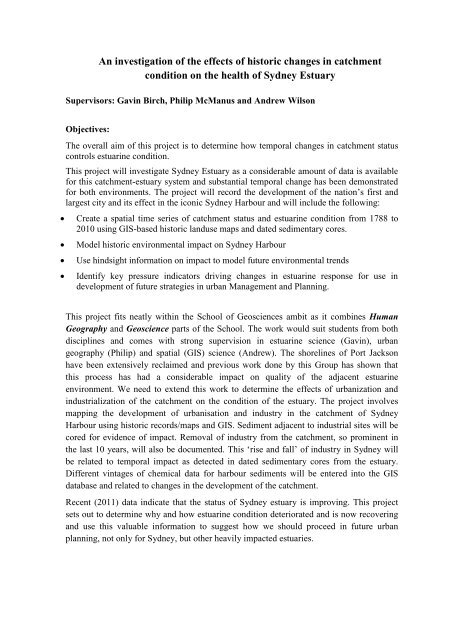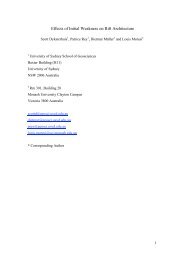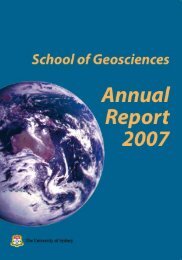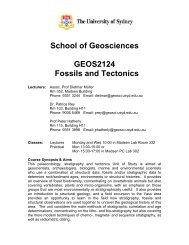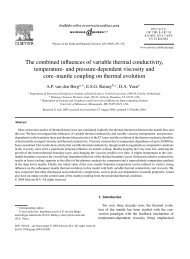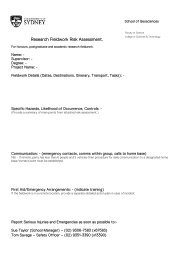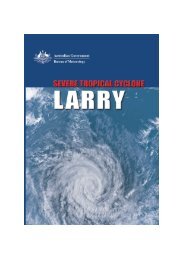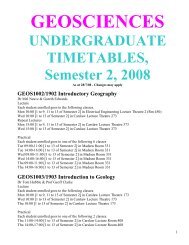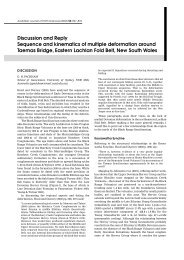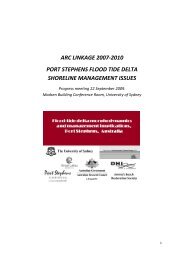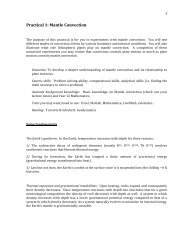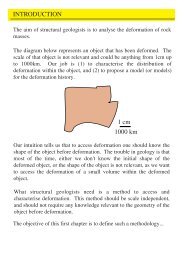Gavin Birch - School of Geosciences
Gavin Birch - School of Geosciences
Gavin Birch - School of Geosciences
You also want an ePaper? Increase the reach of your titles
YUMPU automatically turns print PDFs into web optimized ePapers that Google loves.
An investigation <strong>of</strong> the effects <strong>of</strong> historic changes in catchment<br />
condition on the health <strong>of</strong> Sydney Estuary<br />
Supervisors: <strong>Gavin</strong> <strong>Birch</strong>, Philip McManus and Andrew Wilson<br />
<br />
<br />
<br />
<br />
Objectives:<br />
The overall aim <strong>of</strong> this project is to determine how temporal changes in catchment status<br />
controls estuarine condition.<br />
This project will investigate Sydney Estuary as a considerable amount <strong>of</strong> data is available<br />
for this catchment-estuary system and substantial temporal change has been demonstrated<br />
for both environments. The project will record the development <strong>of</strong> the nation’s first and<br />
largest city and its effect in the iconic Sydney Harbour and will include the following:<br />
Create a spatial time series <strong>of</strong> catchment status and estuarine condition from 1788 to<br />
2010 using GIS-based historic landuse maps and dated sedimentary cores.<br />
Model historic environmental impact on Sydney Harbour<br />
Use hindsight information on impact to model future environmental trends<br />
Identify key pressure indicators driving changes in estuarine response for use in<br />
development <strong>of</strong> future strategies in urban Management and Planning.<br />
This project fits neatly within the <strong>School</strong> <strong>of</strong> <strong>Geosciences</strong> ambit as it combines Human<br />
Geography and Geoscience parts <strong>of</strong> the <strong>School</strong>. The work would suit students from both<br />
disciplines and comes with strong supervision in estuarine science (<strong>Gavin</strong>), urban<br />
geography (Philip) and spatial (GIS) science (Andrew). The shorelines <strong>of</strong> Port Jackson<br />
have been extensively reclaimed and previous work done by this Group has shown that<br />
this process has had a considerable impact on quality <strong>of</strong> the adjacent estuarine<br />
environment. We need to extend this work to determine the effects <strong>of</strong> urbanization and<br />
industrialization <strong>of</strong> the catchment on the condition <strong>of</strong> the estuary. The project involves<br />
mapping the development <strong>of</strong> urbanisation and industry in the catchment <strong>of</strong> Sydney<br />
Harbour using historic records/maps and GIS. Sediment adjacent to industrial sites will be<br />
cored for evidence <strong>of</strong> impact. Removal <strong>of</strong> industry from the catchment, so prominent in<br />
the last 10 years, will also be documented. This ‘rise and fall’ <strong>of</strong> industry in Sydney will<br />
be related to temporal impact as detected in dated sedimentary cores from the estuary.<br />
Different vintages <strong>of</strong> chemical data for harbour sediments will be entered into the GIS<br />
database and related to changes in the development <strong>of</strong> the catchment.<br />
Recent (2011) data indicate that the status <strong>of</strong> Sydney estuary is improving. This project<br />
sets out to determine why and how estuarine condition deteriorated and is now recovering<br />
and use this valuable information to suggest how we should proceed in future urban<br />
planning, not only for Sydney, but other heavily impacted estuaries.


